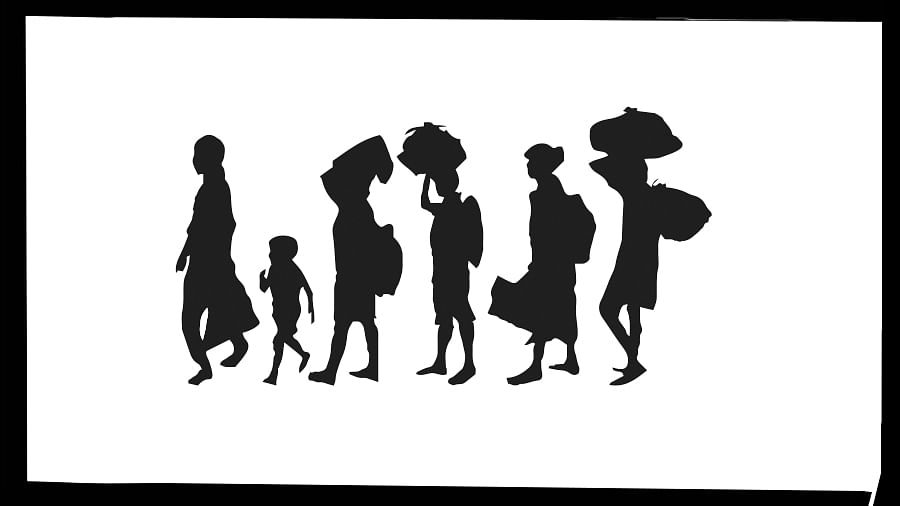
When a regime changes through violent clashes and bloodshed, what happens to refugees and stateless individuals? South Asian countries have witnessed regime changes that have resulted in people either fleeing their homes or being forced to return, with many becoming stateless in the process. At the beginning of this year, the Pakistani government asked Afghan refugees to leave.
In April 2024, the new government in Pakistan announced a deportation policy, affecting the four million Afghans residing in the country. Many of these refugees hold documents issued by the United Nations High Commissioner for Refugees (UNHCR) and government-issued identity cards. Since September 2023, the UNHCR reports that over 639,000 Afghan refugees have left Pakistan to return to Taliban-controlled Afghanistan.
The Afghan refugee crisis dates back to the Soviet Union’s invasion of Afghanistan in 1979, when many began fleeing as refugees. Others left during the Taliban’s initial rule in the 1990s. After the United States’ withdrawal from Afghanistan in 2021, even more Afghans sought refuge in neighbouring countries like Pakistan and Iran. Now, Pakistan has decided to expel them from its territory.
In Bangladesh, during the country’s fight for liberation under Mujibur Rahman, a group of Urdu-speaking Muslims known as Biharis supported the invading West Pakistani troops. After the war, with the help of India’s Mukti Bahini, Bangladesh defeated West Pakistan and gained independence.
Following this, the Biharis were left stateless, as West Pakistan refused to accept them, and Bangladesh viewed them as ‘traitors.’ For years, many lived in Cox’s Bazar, a district in south-eastern Bangladesh, as stateless individuals. However, in 2008, a landmark Supreme Court ruling in Bangladesh ended their statelessness by granting them citizenship. Initially, they were given voting rights and later full citizenship.
In August 2017, a deadly ethnic cleansing operation backed by the Myanmar military against the minority Rohingya Muslim population in Rakhine State triggered the displacement of thousands of Rohingyas. By the end of 2017, approximately 745,000 people had fled to Cox’s Bazar. This district sheltered and welcomed these forcibly displaced Myanmar nationals on an ad hoc basis.
By April 2019, more than 900,000 Rohingyas were living in coastal Bangladesh, and today about 90% of the Rohingya population resides in Bangladesh. Since December 2022, Bangladesh has relocated nearly 30,000 Rohingyas to Bhasan Char, a low-lying silt island about 40 km from the mainland, often referred to as a ‘floating island’ or ‘an island jail in the middle of the sea.’ Trafficking and smuggling of refugees have been rampant from the camps. Muhammad Yunus, the interim leader of Bangladesh, has promised to support the Rohingya community seeking refuge in the country.
Outlining his priorities to diplomats and UN representatives, Yunus pledged that his government “will continue to support the million-plus Rohingya people sheltered in Bangladesh.” He added, “We need the sustained efforts of the international community for Rohingya humanitarian operations and their eventual repatriation to their homeland, Myanmar, with safety, dignity, and full rights.”
Voluntary repatriation is considered the best durable solution for refugees, but this is not happening in South Asia. Tibetans who entered India in 1959 are unable to return, and their exile government in Dharamshala, under the leadership of the Dalai Lama, has supported them for the past 65 years with India’s full backing. Only a small number of Sri Lankan Tamils from Tamil Nadu have returned to Sri Lanka since the onset of the civil war in 1983. According to the Commissioner of Rehabilitation, there are about 58,200 Sri Lankan refugees living in 104 camps across Tamil Nadu, with over 33,200 living outside the camps.
In the late 1980s and early 1990s, tens of thousands of ethnic Nepalese (Lhotshampas) were expelled from Bhutan. More than 100,000 Bhutanese refugees of ethnic Nepalese origin lived in camps in southeastern Nepal until 2006. Many Lhotshampas have since been relocated to Western countries, including the US, Canada, Australia, the United Kingdom, and other European nations. Bhutan did not agree to voluntary repatriation. Similarly, voluntary repatriation of Rohingyas is not happening in Rakhine State, Myanmar. Instead, Rohingyas are either being forcibly repatriated or facing the threat of forced repatriation.
Except for Afghanistan in 2005, none of the South Asian countries are signatory to either the 1951 Refugee Convention or the 1967 Protocol. There is no national policy on refugees in South Asian countries, which makes them vulnerable at all times. A refugee’s right to protection from forced return, or ‘refoulement,’ is a cornerstone of international refugee protection. This right is enshrined in Article 33(1) of the 1951 Convention, which states: “No Contracting State shall expel or return (refouler) a refugee in any manner whatsoever to the frontiers of territories where his life or freedom would be threatened on account of his race, religion, nationality, membership of a particular social group, or political opinion.”
South Asian countries claim that they are not signatories to either the 1951 Convention or the 1967 Protocol, so these agreements do not apply to them. This argument implies that they can repatriate refugees to their countries of origin against their will. However, all countries are expected to adhere to customary international law and global standards that support the safety and welfare of vulnerable individuals.
The right to seek asylum in a neighbouring country is a human right under the Universal Declaration of Human Rights (UDHR), specifically Article 14, which states: “Everyone has the right to seek and to enjoy in other countries asylum from persecution.” In the 2018 Global Compact on Refugees (GCR), the right to asylum, once a human right, is now merely a footnote, mentioned only briefly in the document. The right to seek asylum and offer asylum has faced severe challenges in South Asian countries. Regime changes in these countries often violate this fundamental human right.
(The writer is Senior Fellow, LISSTAR, Loyola College (Autonomous), Chennai)